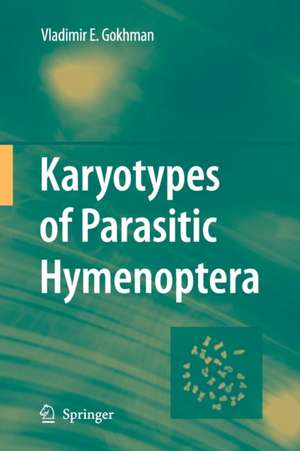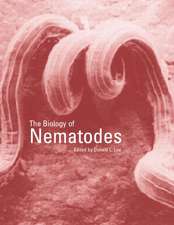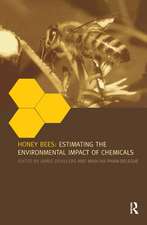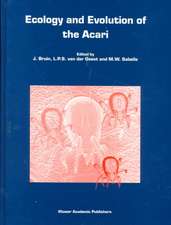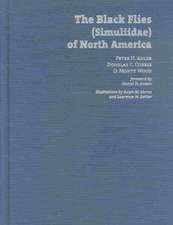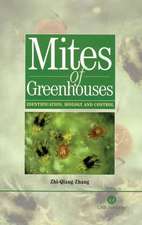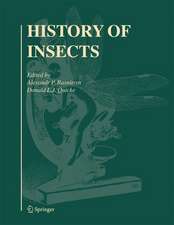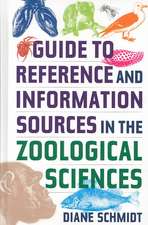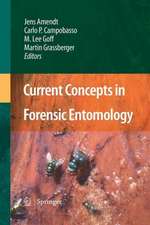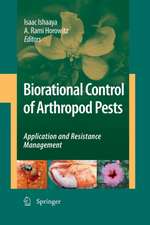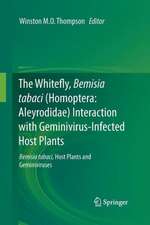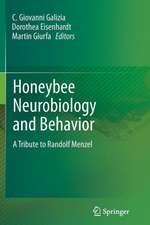Karyotypes of Parasitic Hymenoptera
Autor Vladimir E. Gokhmanen Limba Engleză Paperback – 23 aug 2016
| Toate formatele și edițiile | Preț | Express |
|---|---|---|
| Paperback (1) | 939.94 lei 6-8 săpt. | |
| SPRINGER NETHERLANDS – 23 aug 2016 | 939.94 lei 6-8 săpt. | |
| Hardback (1) | 944.99 lei 6-8 săpt. | |
| SPRINGER NETHERLANDS – 18 mar 2009 | 944.99 lei 6-8 săpt. |
Preț: 939.94 lei
Preț vechi: 1146.26 lei
-18% Nou
Puncte Express: 1410
Preț estimativ în valută:
179.91€ • 195.49$ • 151.23£
179.91€ • 195.49$ • 151.23£
Carte tipărită la comandă
Livrare economică 21 aprilie-05 mai
Preluare comenzi: 021 569.72.76
Specificații
ISBN-13: 9789402404906
ISBN-10: 9402404902
Ilustrații: XIII, 183 p.
Dimensiuni: 155 x 235 mm
Greutate: 0.29 kg
Ediția:Softcover reprint of the original 1st ed. 2009
Editura: SPRINGER NETHERLANDS
Colecția Springer
Locul publicării:Dordrecht, Netherlands
ISBN-10: 9402404902
Ilustrații: XIII, 183 p.
Dimensiuni: 155 x 235 mm
Greutate: 0.29 kg
Ediția:Softcover reprint of the original 1st ed. 2009
Editura: SPRINGER NETHERLANDS
Colecția Springer
Locul publicării:Dordrecht, Netherlands
Cuprins
Chromosomes of Hymenoptera.- Material and Methods.- Morphological Features of Karyotypes of Parasitic Hymenoptera.- Chromosomal Evolution of Parasitic Wasps.- Phylogenetic Implications of Karyotypic Characters of Parasitic Hymenoptera.- Chromosomal Analysis of Parasitic Wasps at Various Taxonomic Levels.
Recenzii
From the reviews:"This book is principally the summary of a large body of work, spanning nearly 25 years, by Vladimir Gokhman [1]. He has carved a niche in karyology of parasitoid wasps and this book has much to offer in the way of chromosome data. The findings are explicitly linked to phylogenetic hypotheses and we are presented with some interesting theories about the evolution of chromosome form and number within the Hymenoptera. ... there are many interesting facts to be gleaned, such as that haploid chromosome numbers for just one family, the ants (Formicidae) range from 1 to 60. ... Some good examples are given in this book. Clearly, karyology has played and still can play an important role in the discrimination of closely related species, but that particular baton has now been taken up by DNA sequencing." Gavin R. Broad in BioMed Central
Notă biografică
Dr. Vladimir E. Gokhman is a leading researcher and the head of the Plant Protection Group of the Botanical Garden of Moscow State University, Moscow, Russia. He works at the Botanical Garden since 1983, after graduating with honour from the MSU Department of Entomology. Dr. Gokhman’s main research interests are karyology and systematics of parasitic wasps. He has defended a PhD ("Karyology and systematics of the subfamily Ichneumoninae (Hymenoptera, Ichneumonidae"; Moscow State University, 1990) and a Doctor of Science (DSc) thesis ("Karyotypes of parasitic Hymenoptera: their evolution and implications for systematics and phylogeny"; Zoological Institute of the Russian Academy of Sciences, 2003). Dr. Gokhman is a member of the editorial board of the Russian Entomological Journal and also a member of the International Society of Hymenopterists and the Russian Entomological Society.
Textul de pe ultima copertă
This summary of the results of chromosomal analysis of various groups of parasitic wasps will be essential reading for those working in the field. It is the second edition of a monograph that was first published in Russian, and has been substantially updated with new data, conclusions and references.
The goal of this ground-breaking work is to document the author’s study of the karyotype structure and chromosomal evolution of parasitic Hymenoptera. It also interprets the results obtained, from both routine and differential chromosome staining, for systematic and phylogenetic purposes.
Despite the huge importance of parasitic wasps, many problems of their taxonomy remain insufficiently studied. This is a situation that needs rectifying, as Hymenoptera are one of the largest and most taxonomically complicated groups of insects and they play a very important role in food chains as parasitoids of the overwhelming majority of insects and other arthropods. Parasitic wasps attack many pests of agriculture and forestry as well as certain beneficial insects. In addition, some secondarily phytophagous Hymenoptera damage certain cultivated plants.
The renowned entomologist and author of this volume, Vladimir Gokhman, has himself developed a particular technique for obtaining chromosomal preparations from adult parasitic wasps. This allowed the inclusion of a wide range of those insects into the study.
The karyotypic features of the majority of superfamilies and families as well as many lower taxa of parasitic Hymenoptera are listed, while the plesiomorphic and apomorphic character states of chromosome sets of parasitic wasps are revealed.
The structural features of karyotypes used for identifying and discriminating sibling species and similar forms are shown, as are the data on chromosome sets of about 400 species of parasitic Hymenoptera (including more than 200 micrographs). Also included is a comprehensive phylogenetic and taxonomicanalysis of karyotypic information.
This book is unique because it demonstrates a range of karyotypic data for an insect group that seemed unattainable in this respect not so long ago. Rich in new facts, techniques and ideas, it will be of use to all those interested in karyology and Hymenoptera.
The goal of this ground-breaking work is to document the author’s study of the karyotype structure and chromosomal evolution of parasitic Hymenoptera. It also interprets the results obtained, from both routine and differential chromosome staining, for systematic and phylogenetic purposes.
Despite the huge importance of parasitic wasps, many problems of their taxonomy remain insufficiently studied. This is a situation that needs rectifying, as Hymenoptera are one of the largest and most taxonomically complicated groups of insects and they play a very important role in food chains as parasitoids of the overwhelming majority of insects and other arthropods. Parasitic wasps attack many pests of agriculture and forestry as well as certain beneficial insects. In addition, some secondarily phytophagous Hymenoptera damage certain cultivated plants.
The renowned entomologist and author of this volume, Vladimir Gokhman, has himself developed a particular technique for obtaining chromosomal preparations from adult parasitic wasps. This allowed the inclusion of a wide range of those insects into the study.
The karyotypic features of the majority of superfamilies and families as well as many lower taxa of parasitic Hymenoptera are listed, while the plesiomorphic and apomorphic character states of chromosome sets of parasitic wasps are revealed.
The structural features of karyotypes used for identifying and discriminating sibling species and similar forms are shown, as are the data on chromosome sets of about 400 species of parasitic Hymenoptera (including more than 200 micrographs). Also included is a comprehensive phylogenetic and taxonomicanalysis of karyotypic information.
This book is unique because it demonstrates a range of karyotypic data for an insect group that seemed unattainable in this respect not so long ago. Rich in new facts, techniques and ideas, it will be of use to all those interested in karyology and Hymenoptera.
Caracteristici
The first monograph dedicated to the study of karyotype structure and chromosomal evolution of parasitic Hymenoptera The author had elaborated a particular technique for obtaining chromosomal preparations from adult parasitic wasps that allowed including a wide range of those insects into the karyotypic study Data on chromosome sets of about 400 species of parasitic Hymenoptera (including more than 200 micrographs) as well as comprehensive phylogenetic and taxonomic analyses of karyotypic information make the monograph an indispensable book for those interested in the taxonomy and genetics of the group
